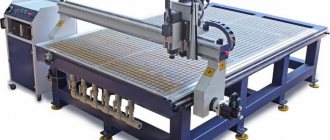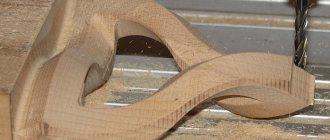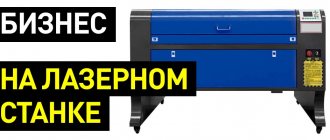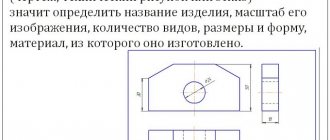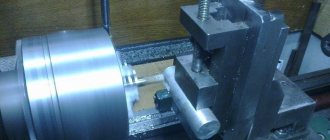A CNC machine is a high-performance hardware and software system designed for processing the following materials: metal, rubber, wood, plastic, leather.
The wide range of applications allows the equipment to be used for development in various business niches. If you are one of the craftsmen who know how to work on it, consider the option of starting a profitable business manufacturing a wide range of products at home.
Its advantages :
- Low starting investments from 150 thousand rubles.
- Availability of a minimum of equipment and tools
- Small space requirement
- Possibility of organization in your own garage or at home
- Wide target audience
- Freedom to choose a market niche
Minuses:
- Having certain knowledge and skills
- Independent search for sales channels
- Seasonality in most niches
business plan will help you avoid making mistakes at the start and correctly organize the process . It will allow you to evaluate the idea and decide on the concept, calculate the cost of products and the profitability of the business. Let's look at its components and some nuances of its activity.
Demand and competition analysis
The first thing you need to do is study the needs of potential clients for Internet services: Wordstat, Yandex.Vzglyad, as well as the offers and pricing policies of competitors. Think about how you can stand out from them, what additional services you can offer. For example, free delivery of orders, furniture designer services, home measurement, and others.
The versatility of the machine allows you to work with different niches and target audiences, both in the private and corporate spheres. Therefore, gaining a foothold in the service market will not be difficult. The demand for products made from natural materials is growing from year to year. In demand: pieces of wooden furniture, interior parts, original souvenirs, toys, musical instruments and others. All this can be produced on a universal CNC machine .
Practical guidance from a professional
Next, I suggest you read the answer of a professional about what a business using CNC machines is, what knowledge is required for this, and whether it is worth doing it at all. Text taken from this SOURCE .
Question:
Good day everyone. Guys, I need help! I live in a small city and accidentally found out about these machines 2 months ago. So the thought arose, why not try to open your own point) For making paintings, decorations, boxes and various gifts. And partly manufacturing furniture, coffee tables, chairs and balusters. Can you give me some advice? Is it worth trying to open your own point?? Will there be even a small profit from this? Thank you in advance)
Answer:
Hello, Vlad! Your question is often asked in private messages, in groups and on the website. For this reason, I decided to answer this question in more detail. And the first thing I would like to draw your attention to is that my answers and the answers of other people to your question are just a subjective opinion obtained through practical experience. But it may be wrong. Therefore, first of all, trust yourself, your intuition. To understand what I'm talking about, read the story of the inventor of the first telephone, Alexander Graham Bell, and his attempt to sell the patent to Western Junior.
I also want to assure you: if you are sincerely passionate about something and live only for it, you will certainly succeed. But this is psychology. Now let's dive into practice.
Setting a goal
And the first thing I would like to draw your attention to is that this is not an entirely correct formulation of the question. Your central starting point in the question is a CNC machine. The main axiom that you need to learn is that a CNC machine is just a tool that has great adaptability for a specific task (this flexibility is especially good for ultra-small, small and medium-sized enterprises), but still it is just a tool and nothing more. . To make my point more clear, I will give a simple comparison. Let’s remove the words “CNC machine” from your question and replace them with the words “chisels”. Then your question would be simplified as follows: “Hello! I’m thinking of buying chisels and I want to try to cut out paintings, decor for furniture, etc. Also, why don’t I try to open my own point and sell it all?” Perhaps it turned out too exaggerated. But the meaning of my thoughts has become, I think, clearer to you. If in the example with chisels, at least the first thing you need to learn is how to handle them, namely, learn how to make clean cuts (understanding the structure of wood, the direction of the fibers, etc.), learn how to straighten chisels, etc. You will also need to learn how to feel the volume , understand carving styles, be able to draw at least a little, and much more. And the second thing you will need to be able to do is navigate the market and understand the demand of your potential customers, buyers, and you will also need to learn to be a good seller.
Since a machine is not a set of chisels, but a complex multifunctional tool in the hands of a skilled person, when working with the machine you will need to master even more new knowledge and skills.
And here we come to another misunderstanding, which is read between the lines in your question. And the misunderstanding is that you are withdrawing money first. Financial well-being is certainly important, but it should not be an end in itself. Otherwise you will be disappointed, because... In most cases, no start-up business will bring a lot of profit at the initial stage of its existence, and most likely in the first few months or up to a year you will work in the red or with little profit. Therefore, before you engage in production, create a so-called financial safety net (cash savings that will last you for at least 2 years). It is also better not to take out any loans, because current interest rates on loans are initially a “grave” for a starting ultra-small and small business.
I would like to warn you against thinking about easy money. The idea of buying a machine with numerical control, and then pumping up free models of icons and carvings, then milling them and selling them by the hundreds is initially wrong and unviable. My opinion is that any orientation of an ultra-small enterprise towards mass production is erroneous, because here we obviously lose in competition with larger enterprises. I will express my opinion that being an individual, a craftsman, as in your case, it is better to focus on expensive individual orders or a small unique series, and here free models will not help you.
Studying programs
When working with individual orders, you will need to solve obviously unique target problems, and this will require you to have certain knowledge and skills in the field of design, engineering work and the creation of control programs for CNC machines (knowledge of CAD, CAD programs, 3D modeling programs, etc. ), carpentry. Below I will describe what software is needed for these purposes and what programs you would like to master (drawing, carpentry, carving, creating control programs for CNC machines).
Paid software:
- Accurate drawing calculations (drawing), construction of complex vectors, design work - this is AutoCAD, CorelDRAW.
- Construction, creation of 3D models: – Polygonal modeling and repathology – this is 3ds Max 2016; – NURBS – this is Moi3d (I use this simple program as a replacement for the standard NURBS tools – modeling in 3ds Max).
- Creation of control programs for CNC machines is ArtCAM 2011.
- Digital sculpture is ZBrush 4R7 (sculpting complex, loose geometric shapes).
Similar free software:
- Precise drawing calculations (drawing), construction of complex vectors, design work - this is LibreCad, Inkscape.
- Construction, creation of 3D models: – Polygonal modeling and repathology – this is Blender.
- Creating control programs for CNC machines is Blendercam.
- Digital sculpture is Sculptris (sculpting of complex, loose geometric shapes).
Operator's work
In addition to knowledge of the programs described above, keep in mind that in addition to design work and writing control programs, you will need to learn how to operate the machine (perform the operator’s work). Eliminate minor problems in the operation of the machine, carry out its maintenance, come up with equipment for fastening workpieces, etc.
Estimate and rental of premises
You will also need practical experience that will allow you to accurately calculate the cost of your work, materials, etc.
Now about the question of opening a point. The interpretation of “point” is not entirely correct. You need a heated room in which you can place a CNC machine and other auxiliary carpentry equipment (essentially a workshop). Please note that in winter the room must be heated stably; the minimum air temperature in winter should not fall below +8 (+10) degrees, because With sudden changes in temperature, warping and cracking of material, such as furniture panels, or damage (warping, torsion) of finished wood products is possible.
Additional equipment and skills
Based on your question, where you express a desire to make boxes, various gifts, and partly want to start making furniture, in addition to a CNC machine, you will need the following auxiliary machines. Below I will give a minimum list of auxiliary carpentry equipment and its purpose:
- Planing machine – planing of workpieces on one side along a plane, chamfering at an angle.
- Thicknesser machine - calibration of solid parts to the exact size (thickness).
- A sawing machine, such as a circular saw, for opening (sawing) workpieces lengthwise.
- Miter saw for cutting (trimming) workpieces to length at a certain angle.
Also, to collect chips when operating a CNC machine and other woodworking equipment, you will have to purchase a hood (chip extractor).
The following mandatory set can be distinguished from hand-held power tools:
- drill
- manual frezer
- Grinder
- jigsaw
- screwdriver
Finishing
Another point that should not be missed is the finishing of your future products. Unfortunately, it is impossible to organize a full-fledged painting booth within a small workshop area. But for small production volumes, specialized oils and waxes can be used in finishing. They are easy to apply to the surface (manual application is allowed without the use of specialized equipment), they will also protect the wood from external influences and give your product a presentable look comparable to a professional finish.
Economic component
Regarding the part of the question regarding profit and sales. First, you need to understand how profit is calculated - these are quite complex calculations. But at first, you can use a fairly simple formula.
PE (net profit) = B (revenue) – SP (product cost) – Administrative and commercial expenses – Other expenses (for example, delivery costs, if they are not included in the cost) – Tax deductions (this also includes rent of premises and utility payments ).
Also, in addition to net profit, you will need to learn to calculate the profitability of production (a kind of efficiency factor of your production). In simplified form, this is the ratio of net profit to the volume of sales of manufactured goods, multiplied by 100%.
Please note that revenue also depends on how accurately you have calculated the costs of producing the product. At the initial stage, this will be extremely difficult to do due to the lack of production experience. At first, even such options will be possible that, due to the cost, you will go to 0 or minus, because You will make common mistakes of beginners, for example, taking on any orders just to gain a foothold in the market. But over time, you will gain experience, and this will not be a big problem for you in the future.
Marketing
And in conclusion, I would like to talk about sales. You need to understand that production itself will not bring you money, but will only wash it away (purchase of materials, cutters, rent, taxes, etc.). You can only earn revenue and, therefore, profit by selling your product. And here you will be faced with a search for potential buyers and customers for your manufactured goods or milling services. As you indicated in the question that your city is small, you may have problems finding customers. But one should not be discouraged here, because... Modern technologies greatly simplify the search for potential customers. My advice to you: actively use the Internet to find customers. Organize your group on VK or Facebook, upload photos of your products there, send mailings to VK users with an invitation to join the group, publish useful copyright information, for example, on carpentry or related areas. Create your own business card website (at first, you can use a free website builder). Another good way to make yourself known and, as a result, find potential customers is to create your own blog on YouTube. There you can post videos of the process of your work on products, or share your work in carpentry, etc. Also take care of a more or less decent camera (entry-level DSLR) and microphone, because you need to understand that the better the photographs of your products in your resume, the higher the likelihood that they will buy or order something from you. Naturally, if your products have practical, artistic or other value.
Room
organize a mini carpentry workshop in your garage or a separate room in the local area if you live outside the city or have a dacha. In the absence of such an opportunity, suitable premises can be rented.
Required area: 20-40 square meters . The room must meet fire safety requirements, be heated and have forced ventilation. When expanding production, additional space will be needed for storage and drying of products.
First launch and first bummer
The machine also requires a computer. I found an old Pentium4 with an LPT port in my bins. Being a Linux person at heart, I chose CNC Linux (https://www.linuxcnc.org/) as the control software. The distribution package was quickly downloaded/installed. With some excitement I turned on the toggle switch, the machine responded with an optimistic buzz.
This is the future, it’s already here! I press Reset and try to move the carriage using the cursor keys. This is where the first bummer happened: everything works great on the Y and Z axes, but there are serious problems with X. The fact is that in my machine there are two stepper motors on the X axis (one each on the right and left guide) and when I tried to move, one of them was spinning, and the second stood dead in place. Thus, the native config that came with the machine did not work in the CNC Linux environment.
The next few hours were spent studying forums and smoking docks. But the maximum that was achieved was that both steppers moved, but they did it reluctantly and at different speeds. Judging by the uncharacteristic sound and the way the portal twitched, at some point, I realized that at this rate I would soon break this expensive piece of hardware to hell, and by force of will I stopped experiments with CNC Linux.
What can be made on a machine
The milling machine allows you to work with various materials in addition to hard ones in automatic mode:
- Carrying out curved and figured cutting of wood
- Production of parts for furniture assembly
- Cutting various materials, including composites
- Decorating blanks
- Manufacturing of complex shaped parts
- Leather and rubber processing
This allows you to start a business by collaborating with entrepreneurs and third parties, supplying them with components, complex geometric elements, and miniature parts. In addition, on the machine it is possible to create unique goods in a single copy, products according to author’s sketches.
Work can begin in several directions:
- Cooperation with small and medium-sized businesses : furniture companies, construction and finishing companies, the advertising industry.
- Manufacturing of furniture decor and assembled furniture, chairs, wooden stairs, doors, trim and shutters
- 2D and 3D carving
- Production of signs, logos, individual samples of outdoor advertising
- Production of corporate, tourist and holiday souvenirs: decorative tableware, medals, memorial signs, magnets
- Development of master models for foundries
2. Fulfilling orders for individuals
- Making wooden toys, board games, kitchen utensils
- Carrying out engraving work on precious metals and stones
- Production of sculptures and souvenirs
- Production of interior items: lamps, panels, stands, photo frames, boxes
3. Launching your own linear production of a specific product that is in demand on the market: cutting boards, coasters, rolling pins, photo frames, etc.
It is worth experimenting with different types of products, quickly switching to producing a wide range.
Selection of wood for the production of supports
In the manufacture of wooden supports, ash, pine, oak, and larch are most often used.
The choice of material is based on the following factors:
- hardness;
- durability;
- wear resistance;
- fiber structure;
- color;
- price.
If you intend to install wooden balusters in structures installed on the street, then the main parameters when choosing should be moisture resistance and resistance to rotting.
The main advantage of pine is the low cost and softness of the wood, which makes it easy to process. Pine supports wear out quickly, are afraid of water and cannot withstand heavy loads.
The price of ash balusters is higher than the cost of pine supports. But such columns will last much longer. At the same time, ash is able to withstand large mechanical loads. Nails should be driven into this material, as into all hardwoods, carefully, preventing the board from cracking.
Larch, like oak, has an optimal price-quality ratio. The red-brown material is endowed with high wear resistance and durability, and is also not susceptible to moisture and rotting.
Interesting articles:
Here we looked at the prospects for making decking boards.
Your own business for the production and sale of chipboards.
Additional income is the production of wood chips.
Search for clients
In order for consumers to know about you and your business to develop, you need to launch advertising . This type of activity allows you to search for clients in both the private and corporate spheres. Due to the wide range of work performed, the following can be used as sales channels for products:
- Access to construction and finishing companies
- Servicing small furniture businesses
- Cooperation with advertising agencies
Sale of products to private individuals: owners of dachas, houses, families with children and other groups of the population
They promote products using their own website, groups on social networks , and specialized Internet sites. Word of mouth works great, distributing visits and booklets in places with high traffic, placing advertisements in elevators and entrances of houses. Be sure to use multiple marketing channels to attract as many customers as possible.
Installation of balusters
Installing wooden balusters is not difficult. It is important to maintain a certain distance between the mounted supports and control the reliability of fixation of each element.
The safety and rigidity of the wooden structure is ensured by balusters installed every 15 cm.
The installation algorithm is simple:
- measurements are taken and the installation locations of the posts are determined;
- the place for fastening is the balusters fixed to the base of the structure;
- holes are drilled in steps and posts for fasteners;
- the fastening element (dowel), like the railing, is fixed with glue;
- The installation is completed by installing handrails.
Fasteners for supports are special rods with a diameter of no more than ¼ of the diameter of the baluster, and a length equal to 2 diameters.
Hiring
If you organize a mini carpentry shop, you will need to hire a machine operator, a technologist, a carpenter, an auxiliary worker, and a driver to deliver orders. You can perform many functions yourself, and use the services of an accountant online, through outsourcing.
Knowing how to operate a machine, at the initial stages it is enough to have one assistant or perform all operations alone. You must register as a self-employed person or individual entrepreneur . The best option would be individual entrepreneurship.
To do this, contact the tax office with a passport, TIN, application, and pay a state fee of 800 rubles. Tax regime: simplified tax system with deduction of 6% from all income or 15% from net profit. Specified OKVED code: 43.32 suitable for joinery and carpentry work.
To receive large orders from enterprises, registering as a legal entity is more suitable. This will require the charter of a company with a capital of 10 thousand rubles, opening a current account and paying a state duty in the amount of 4 thousand rubles.
Woodworking
Solid wood is one of the popular materials for the production of volumetric carved products of high complexity: cabriole legs, balusters, columns, and entry posts.
Parts often have an asymmetrical shape and require 4- and 5-axis setups to process them. In practice, it looks like this: a mechanism for rotating the workpiece and/or a drive for tilting the spindle axis is installed on the portal milling and engraving machine.
It is worth noting that it is also possible to produce complex wood products on a CNC machine with three axes. This will require experience in creating control programs and ingenuity. The square workpiece can be turned over manually. For precise positioning, stops are installed on the table. In a 3D editor, 4 projections of a three-dimensional model of the future part are created and exported to a CAM system for writing a control program. If four revolutions are not enough, take a hexagonal blank and create 6 projections.
How much do you need to invest at the start?
The initial investment depends on the range of work performed and specialization. With a narrow list of services, you can get by with an inexpensive machine model and a minimum of tools. The costs in this case will be 150 thousand rubles, of which:
- To purchase a machine you will need at least 100 thousand rubles.
- For the purchase of equipment for processing materials - 10 thousand rubles.
- To pay for the rent of the premises - 30 thousand rubles.
- For advertising – 10 thousand rubles.
Current expenses will include: purchase of consumables, payment of utility bills, rent, advertising, which will amount to about 40 thousand rubles.
For greater productivity, you will need a complex machine model costing 200 thousand rubles. and equipment with furniture for 25 thousand rubles. Monthly expenses will also increase to 100 thousand rubles.
Having suitable premises and tools and purchasing used equipment will allow you to save. When purchasing a machine, study its technical and operational characteristics and operational capabilities. Choose equipment from reliable manufacturers who are responsible for the quality of the product.
Ideas for commercial applications of machines.
In itself, a CNC milling machine is just a machine without a driver; its full use and, accordingly, the production of sought-after and high-quality products depends entirely on the person, and how competent the person is, the successful the business.
A simple example of using a machine from category 1b for the production of custom-made furniture, both in single copies and in small batches. Olya from Olie's Wood Shop makes a custom Credenza (chest of drawers, low horizontal cabinet) from double-sided laminated plywood.
Video source.
How much can you earn
The amount of income depends on the cost of the processed material, which can range from 20 to 500 rubles. per meter and extra charges of 50-100% . At an average speed, up to 3 thousand meters of material can be processed per shift, which will allow you to earn 170 thousand rubles. per day, and the amount of net profit for the month will be 370 thousand rubles. Thus, the initial investment will pay off in 2-3 months.
The organization will bring additional income:
- Thematic master classes, training courses
- Video lessons on the Internet, consultations
Product description and manufacturing diagram
When starting to manufacture wooden balusters, you need to familiarize yourself with their design features, including:
- a base fixed to the floor, threshold, step using a baluster (rail);
- decorated central part;
- support for railings or handrails.
Simple instructions on how to make a baluster in a small production workshop are as follows:
- The choice of material for supports depends on several factors: the material of the main structure, requirements for the appearance of the product and the method of fastening.
- Determining the size of balusters. It should be remembered that when installing supports, their height decreases slightly. Therefore, for railings with a height of 90 cm, the best option would be posts whose length is 85 cm.
- A regular edged board is cut into square blanks of the same size. A machine equipped with circular saws processes such elements easily and quickly.
- Calibration will help give the product an even and smooth appearance.
- The workpiece is cut on a cross-cutting machine: damaged areas, chips and other defects are removed.
- Using a lathe, the center of the product, the base and the support are formed.
- Once the baluster has received the desired shape, you can begin decorative work: carving, applying paint, varnish or impregnation.
Workshops whose activities include the manufacture and sale of wooden balusters for stairs often accept turnkey orders. That is, the specialist performs the full cycle of work, from measurements to installation. In this case, the shape of the baluster is developed jointly with the customer and executed according to the approved sketch.
Possible business problems and risks
Since the machine is controlled by numerical control, the operator practically does not take part in its operation. Therefore, the influence of the human factor is not relevant for this business. Common risks include:
- Material defects or poor quality: purchasing from a regular, reputable supplier will help you avoid the problem
- Increased competition: high quality products, attractive prices, additional services, and product exclusivity will help minimize the risk
- Lack of demand: indicates insufficient marketing activities, incorrectly chosen niche or pricing
With the right approach to business, risks can be avoided or their impact can be minimized.
The peculiarity of the business is that without ensuring stable sales volumes and established infrastructure, production should not be expanded. It is better to consolidate success by developing it, improving the quality of products, establishing production chains with partners, and retaining customers.
Home CNC router as an alternative to a 3D printer, part four. General processing concepts
Having started writing about processing strategies, I realized that I was creating a “monkey set” - a step-by-step guide not even for dummies, but for idiots, you can repeat my steps, you can make your own according to the model, but it does not add understanding. At one time, when I suddenly decided to become a milling machine operator, having a higher medical degree, an MBA and 10 years of computer retail experience in my background, it was very difficult for me to wade through the terminology and a completely new conceptual apparatus. Of course, most CAM programs are equipped with good help, but it is still written by technologists for operators, and a person on the street cannot always understand what “both in increments” means, why a “cylinder safety area” is needed, what type of lead to choose and what it is generally like that.
Below is my humble attempt to go over the basic concepts of milling with a brief explanation. I used Russian terminology from Delcam textbooks, it may not coincide with other CAM programs, but I think intuition and Google will save the day here. Well, as always, a bit of personal experience in processing plastics on hobby machines.
Spindle speed
In fact, the spindle rotation speed is not an independent parameter; it depends on the tool and material. In the documentation for normal adult cutters there is a parameter “cutting speed” in m/min for different materials, this is the speed of the edge relative to the material.
To calculate the spindle speed, you need to divide the recommended speed by the circumference. But there are 2 problems: firstly, we cut “homemade” materials such as plastics and wood, for which manufacturers do not indicate cutting parameters, and secondly, we use hobby cutters, on which no modes are written at all. So we calculate the speed empirically: we draw a simple groove-type trajectory, launch the cutter into the material at a small (700-1000 mm/min) feed and begin to slowly raise it from 6000. If it starts to melt/burn, we lower it a couple of steps. According to experience, for a cutter with a diameter of 6 mm, the speed in viscous plastics (caprolon, PP, PE) is 6-8K, in hard ones (ABS, PS, PC) - 8-12K, in wood - 15-18K, in wood - 10-20K . When the diameter decreases, we increase the speed, and when finishing, we also increase it.
Feed rate
Feed rate is also a derived quantity, but here it’s even worse - if on the one hand it depends on quite calculated/documented numbers like “feed per tooth”, then on the other hand it depends on the rigidity of the machine-device-tool-workpiece system (aka AIDS ). The feed per tooth Sz or Fz can be found in the documentation for the cutter, where it is described in mm/tooth (mm/t). When multiplied by the number of cutter teeth and the rotation speed, it will give the maximum theoretical feed rate.
But measuring the rigidity of the AIDS system is difficult and unjustified, therefore, as always with homemade people, the feed parameter is selected based on experience: we try different feeds, starting from 500 mm/min (we are talking about plastics, yes) when we stop liking the sound (or break cutter, or the workpiece flies out) - reduce the speed. Do not forget that the feed rate will be different for different cutters and different treatments. The general rule is this: when the removal per tooth decreases, we increase the speed, and when it increases, we reduce it. Although sometimes paradoxical effects occur in plastics, for example, the quality of vertical POM surfaces is higher at higher speeds. On my machines, when processing plastics, I most often use speeds from 1500 to 3000 mm/min, the surfaces are quite good.
Security area
The safety area, also known as OB, is a set of areas of the machine where CAM believes that it is guaranteed not to encounter either a workpiece or fasteners. Transitions are made through this area, and fast-feed walking is allowed by default. With conventional 2.5D processing, this is a plane - we fix the part so that it is clear and cloudless over the entire processing area. However, sometimes it makes sense to specify the OB differently, for example, if we are milling only the sides of the workpiece, but are attached through holes in the workpiece in the center. In addition, some cutters do not offer the possibility of vertical or even inclined cutting into the material, and it is necessary to explain to CAM that transitions and approaches should only be from the side. In most normal CAMs, the OB types “block”, “cylinder” or even “model” are provided for this, specifying the OB accordingly.
Inlets and outlets
Many materials and types of processing allow you not to bother with the concept of leads at all - PVC, PS, soft wood varieties are cut in any direction with any cutter in the standard processing mode. We set the plunge feed and drove off. However, the moment of entry into and exit from the material differs both for the cutter (uneven load on the plane, working with the center of the cutter during vertical cutting of multi-flute cutters) and for the material (burr hanging, knocking out chips). Therefore, CAM programs usually provide the ability to set separate modes for inputs and outputs.
- Approach “along a vertical arc”
- Branch "straight"
- Transition "both in increments"
- Approach - moving at an accelerated
- Lifting - moving at accelerated speed
On the one hand, in the homemade camp, everything is simple here: the materials are soft, the modes are already gentle, so many people generally disdain this parameter and install vertical inlets and outlets. On the other hand, a chip knocked out on a wooden bas-relief at the very end of many hours of processing or a vertical wall damaged by the vibration of a cutter during the lowest of 50 passes is very unpleasant. Therefore, we use it wisely: when roughing with normal (obviously larger than potential defect) allowances, we work rigidly, we set minimal vertical leads; for finishing or fine work, we bring them along an arc or obliquely, depending on the operation. But again, don’t act like a fool; long inlets and outlets greatly increase the total processing time. When finishing plastics, I place the feeds obliquely for operations with horizontal and inclined surfaces and “horizontally along an arc” for operations with vertical walls. The length of the inlet is selected individually, I set 2-3 cutter diameters or 10-15 removal thicknesses.
Heights
Actually, with heights everything is relatively simple.
There is an absolute safe Z, determined by the OB. But imagine that you are working on the inscription on the bottom of the box with an offset in very small increments. A lot of small transitions, at each CAM it takes the cutter into the OB, moves it a couple of millimeters and then painfully moves down. To avoid this, we came up with a relative safe Z - the height at which you can walk during finishing operations after the final cut. You just need to remember that if the selection is not made in real life, for example, the operator mixed up the order of the trajectories, the tool will try to move between segments in the material, simultaneously turning the workpiece and breaking. My personal parameters for small parts are absolute safe - 5-10 mm, relative - 2-5 mm.
Transitions and gaps
Transition is the section of the trajectory between the working strokes of the cutter. As already mentioned, it can be done at an absolute or relative safe height; in Powermill the corresponding settings are called “safe” and “both in increments”. But sometimes, especially on finishing or finishing trajectories, it makes sense to organize the transition differently, so CAM programs provide options:
- On the surface. Despite the fact that correctly configured approaches and retractions leave practically no traces of tool separation on the workpiece, sometimes, for example, if the transition distance is small, it makes sense to make the transition without tearing off the cutter at all.
- Z step. Correct choice for paths with constant closed machining of vertical walls, for example, constant Z
- Directly. A real hardcore option, CAM ignores everything and stupidly lays a straight line between the outlet and the inlet. And woe to the material encountered along the way, minus the salary of the operator who screwed up both the cutter and the workpiece. But respect and respect to the hero, who correctly used the tool and reduced the time of transition to the clock (no joke, this happened).
It’s even difficult to recommend something here. Probably for a beginner the general rule is this: samples - “safe” or “both in increments”, vertical walls - “step along Z”, 3D offset or surfaces - “along the surface”.
Allowances and tolerances
A very simple, intuitive point.
Tolerance is a size that you don’t care about and within which the CAM can be adjusted as it wants. On the one hand, greater tolerance means more freedom for CAM, smoother trajectory, fewer direction changes, and so on. On the other hand, in rare cases, CAM can, for example, place an unloading sampling entry in the middle of a vertical surface, and regardless of the overall size of this area according to the drum, the surface will become ugly. In our age of large amounts of memory and powerful computers that calculate trajectories, it’s better for CAM to think a little longer and write an extra couple of megabytes in the program than to scratch its turnips later on what to do with the flaws. I put a tolerance of one hundred on the plastics, I seem to be happy with everything.
Allowance is initially a concept about roughing. At the CAM level, the allowance looks like the construction of an equidistant (uniformly offset) model from the original model. I have already given the general rule above - the size of the allowance must be obviously larger than the size of the potential processing defect, then even if there is trouble, you can correct the flaw with further processing. In addition, the allowance can be used for other purposes, for example, to scale the model when fitting matching grooves/bosses. On plastics in rough processing I set an allowance of 0.3-0.7 mm, this is enough.
In general, something like this. Now you can start an article about building processing in CAM, without being distracted every minute by wondering whether I’m writing clearly enough and without littering the article with footnotes. If you forgot something or expressed yourself unclearly, write comments, ask questions, I will try to answer.
If anyone missed it, but is interested, the previous articles in the series:
Home CNC router as an alternative to a 3D printer, part one - choosing a machine Home CNC router as an alternative to a 3D printer, part two Home CNC router as an alternative to a 3D printer, part three, software and G-code
Wood decor and consumer goods
If you intend to produce decor from wooden blanks, you need to know that the wood must be well dried, having a humidity similar to the air humidity in the room where processing is planned. To do this, it must lie there for at least a week.
And only then you can use a milling machine to produce coffee tables with carved legs, decorative grilles for masking heating radiators, curtains, stools and candlesticks, original frames, massive wooden crosses, shelves and brackets, armchairs, stands for indoor plants, blinds made of wooden blocks, phone stands, under a frying pan for hot dishes or under cups.
Her Majesty's furniture
It is made from valuable wood or MDF boards. This material is close in composition to natural wood, is easy to process and is inexpensive, it is more moisture-resistant and resistant to microorganisms. This is why CNC milling of MDF facades is in great demand.
They are easy to process, they can be cut and drilled, painted, laminated and veneered.
It is possible to make from an MDF panel:
- linings for armored doors;
- wall panels, with the help of which interior decoration is carried out;
- acoustic system housings;
- elements of cabinet furniture; countertops, wardrobes;
- the finished product for furniture makers (small decor) is then covered with film on a vacuum press.
Plastic milling
Milling machines allow you to process almost all existing types of plastic with high speed and accuracy. Thanks to the use of CNC machines, precision work is achieved not only when working with large parts, but also when processing small products. Depending on the task, it is possible to create even the smallest plastic parts. CNC machines make it possible to process and mill all types of plastic that can be deformed and retain a new shape after machining.
